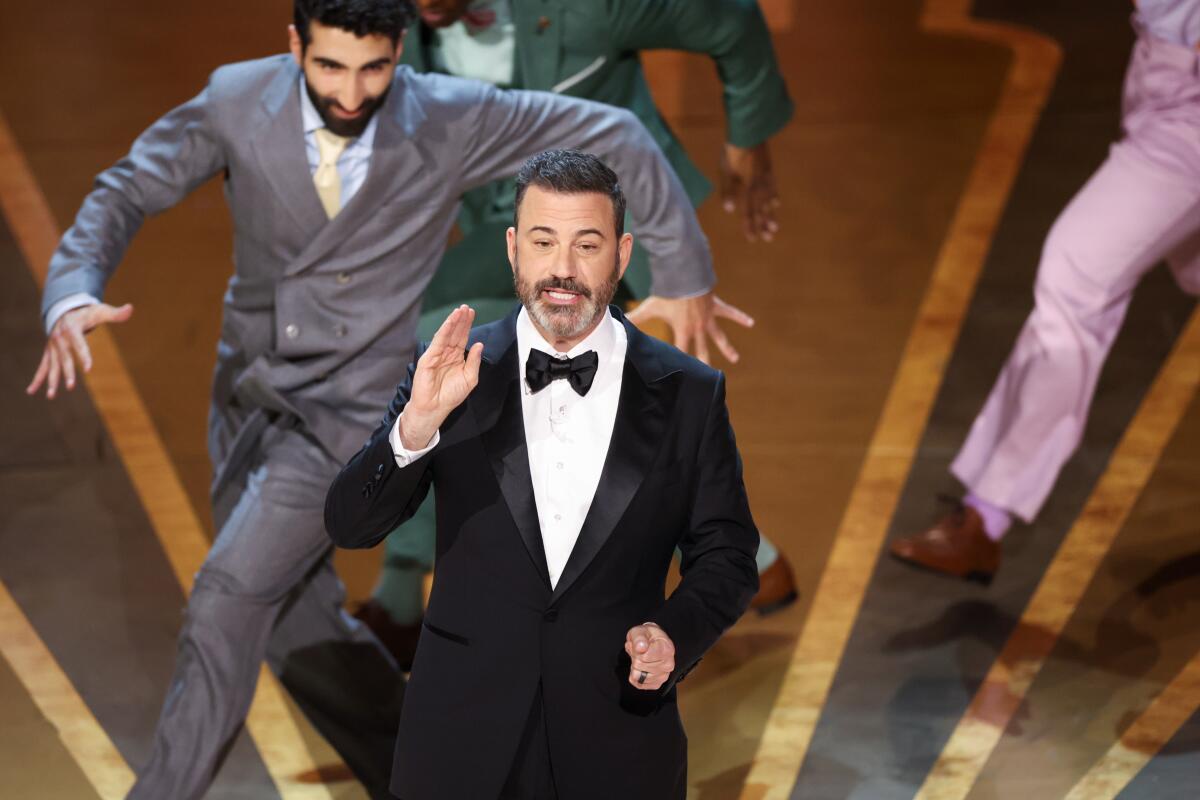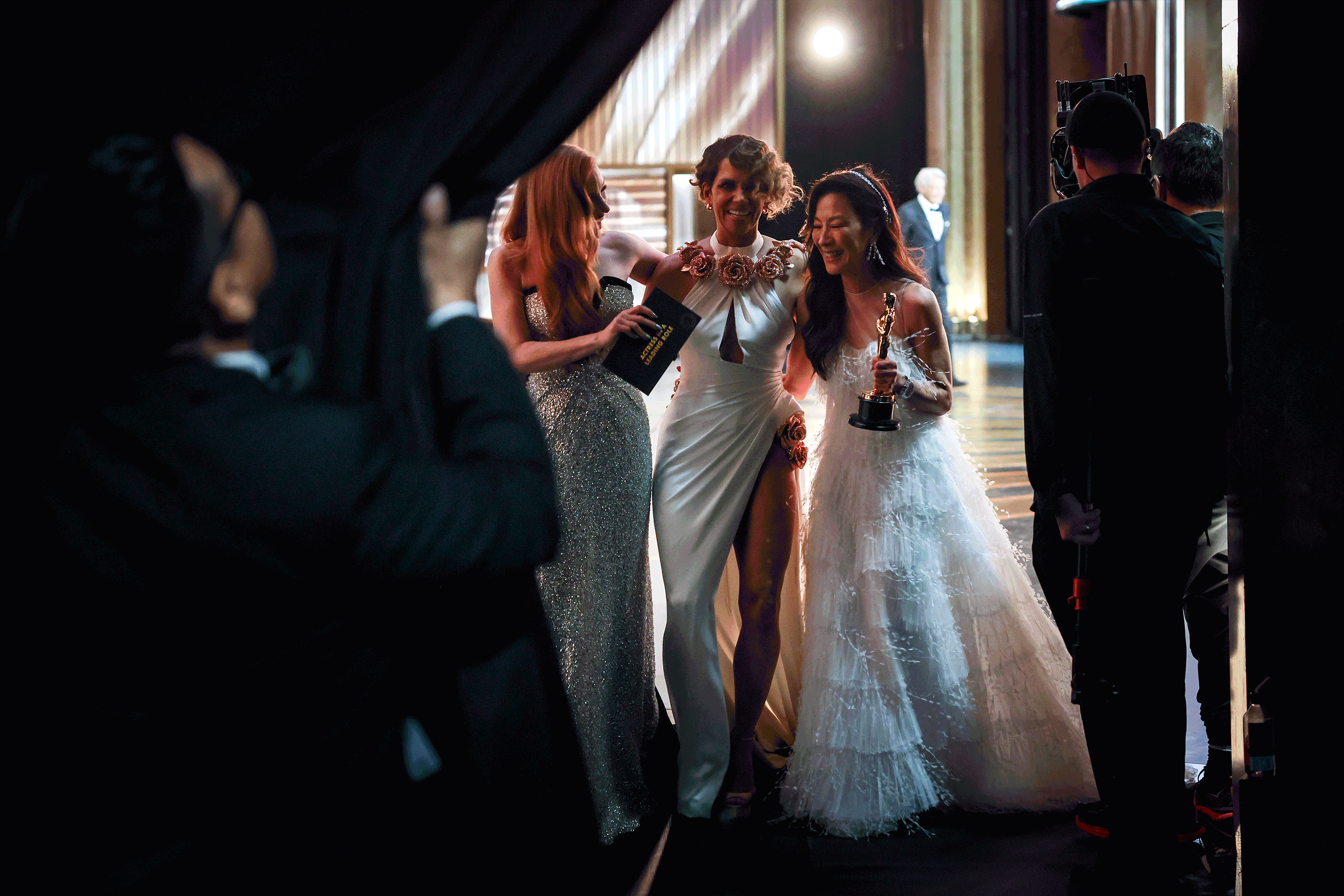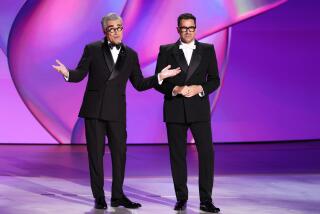ABC’s Oscars telecast scores biggest audience since 2020 with 18.8 million viewers

- Share via
ABC’s telecast of the 95th Academy Awards on Sunday got a post-slap lift in the ratings, according to Nielsen data.
The ceremony from the Dolby Theatre in Hollywood averaged 18.8 million viewers, up 13% from the previous year, when Will Smith’s onstage assault of presenter Chris Rock became a global news story.
It was the largest audience for an Oscars telecast since 2020, when the event drew 23.6 million viewers.
The scandal was expected to draw viewers Sunday who at the very least were interested in hearing how it would be handled by this year’s host, Jimmy Kimmel. ABC’s late-night stalwart emceed the ceremony for the third time.
Last year’s telecast averaged 16.7 million viewers, 58% better than the all-time low of 10.5 million in 2021. The audience for the 2022 ceremony got a lift, as word-of-mouth of Smith’s slap likely drove people to check out the aftermath, which included the star winning a lead actor trophy.
But the audience for Sunday’s telecast remains far below the nearly 30 million viewers who watched in 2019.
The Oscars faced strong competition, as the finale of the hit HBO zombie drama “The Last of Us” ran directly against the telecast, a sign that the awards ceremony is no longer a fearsome event that can scare away counter-programming efforts.
The proceedings felt more upbeat than in recent years, as the effect of the COVID-19 pandemic has subsided and seven-time Oscar winner “Everything Everywhere All at Once” provided several feel-good stories.
An exclusive look at what happened backstage at the 2023 Oscars.
The film’s Michelle Yeoh became the first Asian woman to win a lead actress trophy. Like Yeoh, castmates Jamie Lee Curtis and Ke Huy Quan took home their first Oscars (in the supporting actor categories) after having decades-long careers in the film business.
The Oscars have been battling TV industry trends that have driven down audience levels for awards shows. Streaming video has diminished the traditional TV viewing habit. Younger viewers have increasingly turned to social media and YouTube to watch clips of live events rather than sit through an entire three-hour-plus telecast with commercials.
The Oscars also suffer from being the coda for a months-long movie awards season where some of the same winners are seen giving speeches, likely adding to viewer fatigue and a lack of suspense.
While the telecast is not as big as it used to be, it remains a strong draw for advertisers, with some 30-second ads reportedly selling for around $2 million. Only NFL post-season contests and the Super Bowl attract higher prices.
The motion picture academy promised to deliver a faster-paced telecast than it had in the past while restoring the eight technical awards that were not presented live during the 2022 broadcast.
Speeches by Oscar winners that dealt with political issues and social justice were kept to a minimum, while the diversity of this year’s winners was celebrated. Along with the milestone set by Yeoh, costume designer Ruth E. Carter became the first Black woman to win multiple Oscars.
This year’s telecast also benefited from having several brand-name box office successes nominated, including “Black Panther: Wakanda Forever,” “Top Gun: Maverick” and “Avatar: The Way of Water.” “Everything Everywhere All at Once” is currently at $73 million in domestic ticket sales, the highest for a best picture winner since “Green Book” won in 2019.
A musical performance by Rihanna, whose halftime show at Super Bowl LVII drew higher ratings than those for the game, also likely gave the Oscars telecast a boost.
More to Read
Updates
1:31 p.m. March 14, 2023: This story was updated with final ratings data issued Tuesday by Nielsen.
Inside the business of entertainment
The Wide Shot brings you news, analysis and insights on everything from streaming wars to production — and what it all means for the future.
You may occasionally receive promotional content from the Los Angeles Times.












